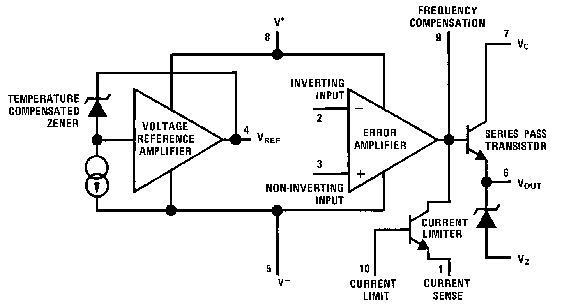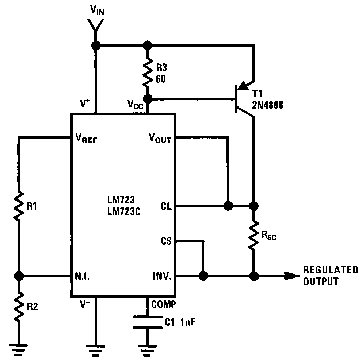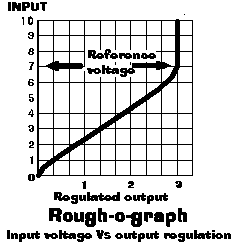Low drop out 723 regulator for battery operation
The requirements here was to produce 3 volts from a small Sealed Lead acid battery. (SLA) The problem was that any more up to date solution was hard to find in this neck of the woods and the job had to be done quickly. All I really had on hand that would regulate down at 3 volts was the standard 723 regulator. And that's where the trouble started.
A standard 723 has two basic sections as this block from NSCs data book shows.

It has a buffered voltage reference and a comparator op-amp section. The buffered reference consists of a temperature compensated zener diode buffered by an op amp. This drives the following section which compares the reference with the output voltage and keeps the output in check around the reference. There are two ways of taken the output voltage above or below the reference. You can either adjust the voltage from the reference into the non inverting input of the op-amp. Or you can adjust the feed from the output voltage into the inverting input of the op-amp. The standard circuit for use with a PNP series pass transistor is shown below.

In this case the adjustment is done through R1 and R2 out of the reference and into the Non-inverting input. Resistor [Rsc] is the current sensing resistor. When a large enough voltage flows through this resistor it pulls the current limiting transistor down and thus the output voltage. Presumably the output of the op amp is through a resistor or something. I've not actually checked but it's not the focus of this discussion. I've used this circuit because I wanted to use an external PNP series pass transistor to get an output current in excess of half an amp. Using an PNP transistor seemed to offer the simplest solution. You can refer to the LM723 data sheet on NSC's web page. The URL can be found elsewhere on this site.
The 723 is quite capable or regulating a voltage down to about 2volts but there's a snag. The voltage reference is set at around 7 volts. What this means is that the input voltage need to be above this in order to regulate. If your 12 volt battery was fully charged then there is no problem. You'll get a nice smooth 3 volts out. But if your battery drops below the reference voltage, which will do when discharging under load, the regulated 3 volt output will begin to drop rapidly. Something like the following.

As you can see from the Rough-o-Graph (tm) the output voltage falls off rapidly after 7 volts even though there is still plenty of grunt left in the battery. The problem is that reference. If it was lower then we might be able to do something about it but there's no way to make that reference lower. However no-one said you couldn't use an external reference! Now zeners aren't known for their smoothness or extreme accuracy. And besides I didn't have a suitable reference on hand. The 12 year olds they employ to serve behind the counters of the electronics retailers these days will tell you that you can't get zeners below 5 volts anyway. Mainly because these toy shops don't stock anything lower so they assume they're not made. If that were the case then 90% of the electronic gadgetry we use these days doesn't exist either. Given that you'd be lucky to be able to build a one transistor amplifier with the range of components these toy shops do actually stock. But I digress.
What I had on hand was an LM336. It's kind of like a zener. It's a 2.5 volt reference diode with a trimming adjustment. You can use it just like a diode thus.

But there are a couple of concerns. Firstly this is a battery application. If the current limiting resistor feeding the LM336 is high we'll get excellent regulation but the reference will drop off too soon. If the resistor is too low then we'll get low drop out but extra current drain on the battery. Especially at full charge. In practice the best trade off seemed to be at about 800 ohms. But then we run into our second problem. The reference voltage is around 2.5 volts. And in practice it's more like 2.2 volts. That's far lower than we require. We can't bump the reference up so another approach need to be taken. Instead of adjusting the voltage of the reference in some way, we can simply adjust the sensing voltage to the inverting input of the op-amp. Or error amp as NSC refer to it. In effect what it's doing is telling the error amp there is less voltage on the output than there actually is. The error amp compensates by rasing the output voltage to the desired level. A simple potential divider or pot can be used. Almost identically to the R1-R2 scheme as suggested in the NSC data sheet.
So the circuit becomes thus.

I used a TIP32 as the outboard series pass transistor simply because it was the first power PNP transistor I came across that could handle in excess of half an amp. You could in fact use anything as long as it delivered the current you need without letting the smoke out. Rsc should be calculated so that it gives you the current you want without the regulator switching off. If you replace it with a direct short the regulator will work but there will be no current limiting. Refer to the NSC data sheet for exact calculations on this.
Having said all of that, the regulator still drops out at nearly 5 volts. 4.7 or 4.8 volts. This was as tight as I could get it given the trade offs. Which means it's still not really suitable for use on a 6 volt lantern battery. But on a 12 volt SLA it should be adequate. The battery can drop to 4.8 volts before you start to loose power on your portable 3 volt device. In most cases you should be able to get down to under 4 volts before the device being powered becomes unserviceable.
Finally. The circuits contain no pin-outs. The pin-outs are below because the devices come in several package types. Oh and why did I need to do this you ask? Well put simply. I got sick of buying batteries and there were a lot of portable things to power. When ever I skate somewhere I've useually got my back-pack on. It's got water and sometimes a pair of shoes, my sk8 tools and whatever else I need at the time. it's no great trauma to also carry a little box with some regulators and a 1.2 or 2 amp-hour SLA battery in it. If I get caught out after sun-set I can run a rather bright 3 volt helogen headlight off it and of course there's my walk-person. Sometimes there could be a lap top and a small portable keyboard to run. It beats using ni-cads and it's actually lighter than a bunch of ni-cads. The whole thing fits in a large-ish zippy box and also incorporates the battery charger electronics. Everything except the transformer. I leave a few transformer boxes at places I'm likely to stop and recharge so I can always get a boost if I need one. And of course it saves me carrying the weight of a transformer around with me. Of course this may not be the most ideal solution but all I had on hand to do it was a 723 and a 336. The external reference idea is not new but no-one I know had ever tried it. I hope this is of some use to someone in the future.

Be absolutely Icebox.






